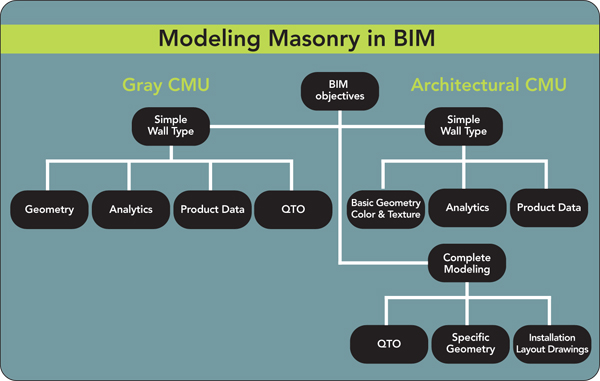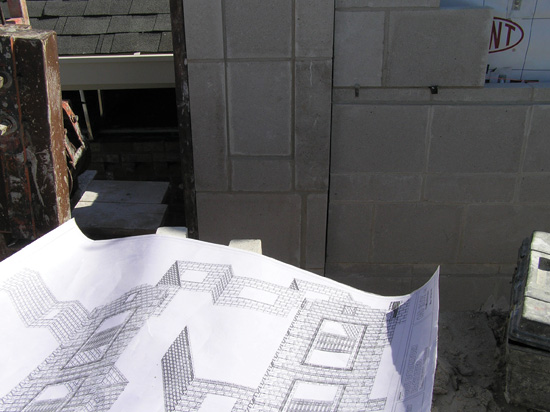BIM Comes to Masonry
How Masonry Fits In
How masonry fits in to BIM and other types of modeling depends on how you define “masonry.” Generally, there is brick and gray CMU, which are comparatively simple, straightforward products, and there is architectural CMU, which refers to more complex units that come in hundreds of faces, glazings, colors, shapes, sizes, and finishes. Brick and gray CMU are relatively easy to model, while architectural masonry is a more complex exercise. The accompanying table sets forth the richer, more robust BIM output for architectural masonry versus gray CMU.

Image courtesy of Oldcastle® Architectural
Special Challenges for Architectural Masonry
As has been mentioned, when it comes to BIM, masonry is in a class of its own. Challenges notwithstanding, the masonry field can benefit from advanced BIM modeling in a number of ways.
Getting Finished Faces Right
In a masonry project, one of the highest priorities is receiving the correct units that reflect the design intent. Often, the approach is to order lesser amounts and add on if in the field it is deemed that more or different units are needed. However, short ordering, as it is known, comes with its own set of problems. Mold set ups and freight costs can add up quickly, and there is also the disadvantage of possible color variations, job delays, loss of productivity, and wasted resources. If a specialized corner unit is required, for example, that condition is on hold until a proper unit can be delivered, which can upset the schedule of all related work. For masonry, it really pays to get things right the first time around.
Product Limitation
Model builders with a close relationship with manufacturers enable selection of the proper units from the manufacturer's line. If a custom unit is required to handle a condition, the required shop drawings for the plant are produced. Too, models can often help in laying out conditions using less expensive methods, and can help prevent those small add orders for a product that wasn't initially thought to be needed.
Design Preservation
Modeling can help with resolving the geometry problems within the overall building shell. In fact, some architectural masonry projects are so complex that their geometry cannot be resolved without an analytical tool. Case in point is St. Mary's Academy, a school project in New Orleans, which involved such complicated geometry that constuctibility and cost issues threatened to jeopardize the project. The design involved more than 140,000 glazed CMUs; more than 100 unique shapes further multiplied by multiple color, score patters and bonding methods to be shipped in various quantities—or more accurately put, 350 unique items. Because of the intended single wythe wall construction, the design was compared to a 140,000-piece 3D puzzle with a photo on each side. When the architects presented the design to contractors, a unanimous vote of “impossible to build” was returned. The only alternative was to build two 4-inch walls to separate the complexity—an approach that was cost prohibitive and not desired by the architects who stood behind their design. Detailed masonry modeling during the design phase, however, salvaged the design, and resulted in precise identification, ordering, and installation of each masonry unit. The technology was used to control costs and preserve the design intent.

Image courtesy of CAD BLOX LLC
BIM can model—and help resolve—the complex geometry of a masonry project.
Special Attention to Correct Installation
Many times 3D layout drawings take the guess work out of building with architectural CMU. The unit codes in the drawings match the codes on the pallets facilitating accuracy and cost effectiveness in the field. Drawings can show, for example how to start the bond so the order will work for all openings, corners, etc. “Using 3D layout drawings from a BIM model makes my life easier—a time-saving service for us all the way around,” says Charlie Adams, masonry foreman, D&D Masonry. The value of this productivity boost has even been seen in relatively uncomplicated gray CMU.

Photo courtesy of Oldcastle® Architectural
Modeling can help streamline the staging of a masonry job.
There is such a diversity of masonry elements that even the most well versed architects or field personnel may not be familiar with every type of unit. Consider an 8JOTX X=8 glazed unit, for example—a unit that not everyone may recognize. In a practical sense, drawings coded to match the packing slips on the block order can simplify efforts in the field. Modeling software can put a picture with the codes for instant recognition that help boosts productivity.
Staging Complex Orders
Once the model has been produced, project team members can isolate portions of the building for changes if necessary, or produce sub orders based on job staging requirements, increasing the effectiveness of deliveries and ensuring that products arrive on time in the sequence required. If the product is damaged, lost or needs to be changed, models can help rectify the situation, with the pertinent information easily obtained for better field management. A proper masonry model allows for each truck to be loaded with the proper blend of units based on installers work flow.









